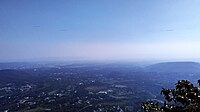
Photo from wikipedia
The characteristic site response spectra of soft sedimentary rocks in the Garhwal Himalaya and a few localities in the adjoining Ganga plain and Himachal Himalaya have been studied through short… Click to show full abstract
The characteristic site response spectra of soft sedimentary rocks in the Garhwal Himalaya and a few localities in the adjoining Ganga plain and Himachal Himalaya have been studied through short period passive seismic source experiment using ambient noise data. Along with this, stand-alone temporal gravity data in the Doon valley was also acquired. It has been observed that there exist two extreme frequency bands in the gravity and seismic response spectra of alluvial soft sediments in the Doon valley and the adjoining regions, when it subjected to micro-seismic and gravity-tidal oscillation. The concept of damped harmonic oscillator was used to study the fundamental long period modes in the density driven diffusive fluid flow in the valley alluvial pore spaces, and observed that the flow was continued from minutes to a few days. In this case, apart from the diurnal component, the observed fundamental modes are in the bands from 0.42 to 1.83 days. The characteristic frequencies of seismic response spectra for the fundamental modes of thick soft sediments were also studied using the spectral ratio (HVSR) method of Nakamura. In the Ganga basin, a moderate resonant frequency of 3 Hz is sufficient for thick soft sediment to cause relatively large vertical amplitude, which suggest possibility for sub-surface secondary seismic effects like liquefaction. However, the hard rock terrains in the lesser Himalaya, where only a veneer of soft sediment is present, show relatively high frequency values of 15 to 18 Hz even to produce an H/V amplitude ratio of 1 and 1.7 and hence could be considered as relatively stable.
Journal Title: Journal of the Geological Society of India
Year Published: 2018
Link to full text (if available)
Share on Social Media: Sign Up to like & get
recommendations!